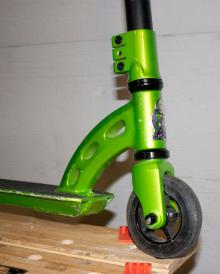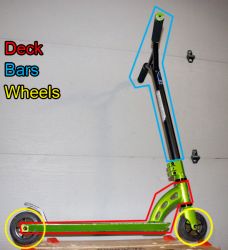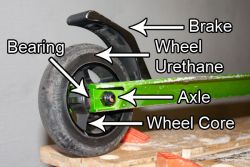
This article originally appeared on ScooterDad.com and has been reposted here for posterity.
The first step to maintaining your scooter is knowing what all the parts are. It’s a lot easier to order a new “fork” than it is to order a “you know, that long metal thingy with the tube part and the U-shaped part that holds the spinny jobby”. :o)
Many of you reading this blog will undoubtedly know quite a bit about scooter parts already, but since the focus of my blog is educating beginners and parents, I thought it wouldn’t hurt to write an article outlining the basic parts of a freestyle scooter. If you already know what all the parts on a scooter are, then move along, these aren’t the droids you’re looking for. However, if you’re brand new to scootering, then hopefully this article will be a helpful starting point in getting you familiar with freestyle scooter parts.
When someone at the skate park tells you that you need a new headset, you might not even know what a headset is, so how can you determine if you truly need a new one? Many of the parts on a scooter will have names that are easily identifiable and recognizable to you have any experience with bikes, motorcycles, or other similar riding equipment. For the sake of being thorough, I’ll cover all the major parts.
Deck
The deck is the largest and heaviest part of the scooter. It is the main platform on which the entire scooter is built. In addition to the primary area of the deck (where you put your feet), the deck also includes the headtube (or downtube, steering tube), which houses the main steering column, and the neck (or gooseneck) which supports the headtube. The rear U-shaped area of the deck where the wheel mounts near the brake is called the dropout.
Decks are almost always made of aluminum and they can be constructed from stock pieces (TSI, models prior to the Flight Deck), CNC machined from solid billet aluminum (Lucky, Zero Gravity, Proto, ProRide), or extruded through a mold (Phoenix, Blunt, Razor, etc.). Decks may have mixed parts where the deck and the neck are extruded and the headtube is cast aluminum, or another similar mix of manufacturing processes.
Riders are often concerned with weight and headtube angle as these two factors can greatly affect the feel of the deck. Weight balance from front to rear as well as the amount of concave to the top of the deck are other factors riders must take into account when selecting a deck. Decks can be integrated or non-integrated. I’ll explain what this means below in the section about headsets.
Bars
Riders are also extremely particular about their bars (short for handlebars) in regard to the height, width, and shape. Bars are the primary connection between the rider and the scooter, so personal fit and feel is very important. Each rider will prefer a different relative height and width that suits their size and riding style. Most bars are made of steel, but some are made of aluminum. While aluminum bars are lighter, they are also more fragile and they can be more difficult to fit to your scooter.
In addition, some bars have sweep, which refers to the degree of angle that the bars pull back from a perfectly straight horizontal line. That is, if you’re looking down on the top of the handle bars, zero sweep would mean that your hands are perfectly parallel with each other, like a straight T-bar. Any degree of sweep would indicate that handle part of the bars are slightly angled back toward the rider.
The fit between bars, clamps, and compression systems are a much bigger discussion than I’m going to go into here, but here are a couple key points:
- If you’re using an HIC compression system or a threaded fork, you’ll need a slit cut in the lower part of your bars so that the clamp can compress the bars on to the fork.
- If you’re using an SCS compression system, you DO NOT want a slit in your bars and they will need to be cut 2 inches shorter than you want the overall height to be because the SCS clamp raises your bars 2 inches.
If you’re not familiar with the various clamping and compression methods, look for a future article outlining the details of this aspect of scooter building.
Grips and Bar Ends
Like bars, grips are an important aspect of the rider’s connection to the scooter. ODI Longneck grips are the most commonly preferred grips among riders, but many also like Animal Edwin grips. Both of these grips are available in an assortment of colors. Other BMX style grips will work as well, but motorcycle grips will not work because the throttle-side grip is larger to accommodate the throttle tube. Nearly all riders choose to cut off the flanges (the fin/ridge by your thumb and index finger on one end of the grip) so that their hands don’t rub uncomfortably against the flange or get hung up when doing bar spins, bar twists, and other tricks.
ODI Longnecks and Animal Edwin grips come with plastic bar ends that you can hammer into the end of the bars. Depending on the thickness of the bars, you may need to trim the bar ends to make them fit properly. You can also buy aftermarket metal bar ends separately from companies like Madd Gear. Bar ends are important because they protect the rider from the sharp metal edge of the bars. You don’t want to fall and your scooter and have a sharp metal edge of your bars carve a nice 1” scoop out of your shin!
Clamp
The clamp secures the bars to the fork of the scooter so that they rotate in sync and do not slip apart from each other. There are many different clamps and several styles of clamps available. On a basic Razor scooter, the clamp simply compresses the lower part of the bars on to the threads of the fork.
Clamps can also be part of a compression system that further ties the bars and forks together. HIC (Hidden Internal Compression), SCS (Standard Compression System), ICS (Inverted Compression System), and Phoenix’s new TLC (Thread Lock Compression) systems offer better stability than basic clamping systems with threaded forks and headsets, but they require special parts and an understanding of how to make them work correctly.
Headset
The headset consists of the bearings, bearing cups, fork race, and top cap (and sometimes compression ring) that allow for smooth rotation of the fork within the headtube. Headsets can be threaded or threadless, sealed or unsealed. Threadless sealed headsets are the highest quality, but they also require a threadless fork and some kind of compression system. They are also more expensive, but well worth the cost.
I mentioned earlier that decks can be integrated or non-integrated. An integrated deck has bearing cups that are built into the headtube. Integrated decks are more expensive, but they provide a much better fit for the headset and ensure perfect alignment for smooth fork rotation. Installing and removing bearing cups is the most difficult and painful process in scooter building and maintenance. I do everything I can to avoid having install or remove bearing cups and I recommend that you do the same. The extra cost is a small price to pay in saving the blood, sweat, and tears you will shed on bearing cups.
Fork
The fork supports the front wheel and extends through the headtube to the bars where they are joined together with a clamp. Like headsets, forks can be either threaded or threadless, but you need to pick the same format for both fork and headset. Choosing threadless or threaded will also impact your clamping system choices as well as your bars.
Forks can also be regular or zero-offset, which refers to where the axle is located in relation to the center line in the fork. Zero off-set forks have the axle located right in the middle of the fork, which means that the wheel is in the same location regardless of whether the bars are forward or backwards. Regular forks will have about a 10mm forward offset which provides just the right amount of “trail” for easier steering and better handling. For a quick explanation of how offset, rake, and trail work, check out this link: http://bikearama.com/theory/motorcycle-rake-trail-explained/
Brake
The brake mounts to the scooter either through a bolt in the top part of the deck (like a Phoenix), a horizontal bolt through the side of the deck (like a Razor), or through the rear axle via a brake carrier (like a District). Brakes can be spring-loaded (Razor), spring steel flex-resistant (Phoenix Switchblade), or rubber mount-resistant (District).
Spring-loaded brakes are what you will find on most beginner scooters, and they work decent, but the springs and mounting bolts break easily and they are noisy (difficult to dial). I prefer the fit of a spring steel flex-style Phoenix Switchblade because it can be fitted to most decks with minimal modifications, it works well, and it doesn’t rattle.
Wheels, Bearings, Axles, and Spacers
Scooter wheels have two parts: the core and the urethane. To compare it to a car, the core functions like a car’s wheel and the urethane functions like a car’s tire, except that they are permanently bound together. Most beginner wheels have cores made of plastic which will break fairly easily once your scooter kid starts doing more advanced tricks or once he starts exerting significant force in his landings. Metal core wheels provide much better support for freestyle tricks and they are more resistant to breakage. Metal core wheels are more expensive, but lower-end metal core wheels can still be found for reasonable prices, such as Yak-brand wheels.
The wheel’s urethane will be made of different compounds, depending on the brand and model, which will affect the wear, grip, and rebound of the wheel. Riders will have their own preference for various urethane compounds. Cheaper wheels are made of lower quality urethane that can more easily “dehub”, or separate the urethane from the metal core.
Wheel bearings go inside the core of the wheel to provide a smooth rotation on the axle so that the wheel can roll. Bearing spacers are small metal cylinders that go between the bearings inside the core to keep the bearings held apart at the correct spacing so that compression from a tightened axle cannot damage the bearings resulting in reduced performance. Inward Scooters sells heavy duty bearing spacers for $2 that work extremely well.
The axle mounts the wheel to the deck through the bearings and the spacer. Decks and forks often come with axles, but you can also purchase replacement axles at hardware stores. You won’t be able to find an exact replacement scooter axle, but you will be able to find a quality bolt and nylock nut that will work as a replacement axle. In fact, bolts and nuts are made from hardened steel that are more durable than stock axles in many cases. I recommend black oxide alloy steel socket cap screws and nylock nuts, which can be easily found at Ace Hardware or your local hardware store. Take your deck with you to determine the correct diameter and length.





